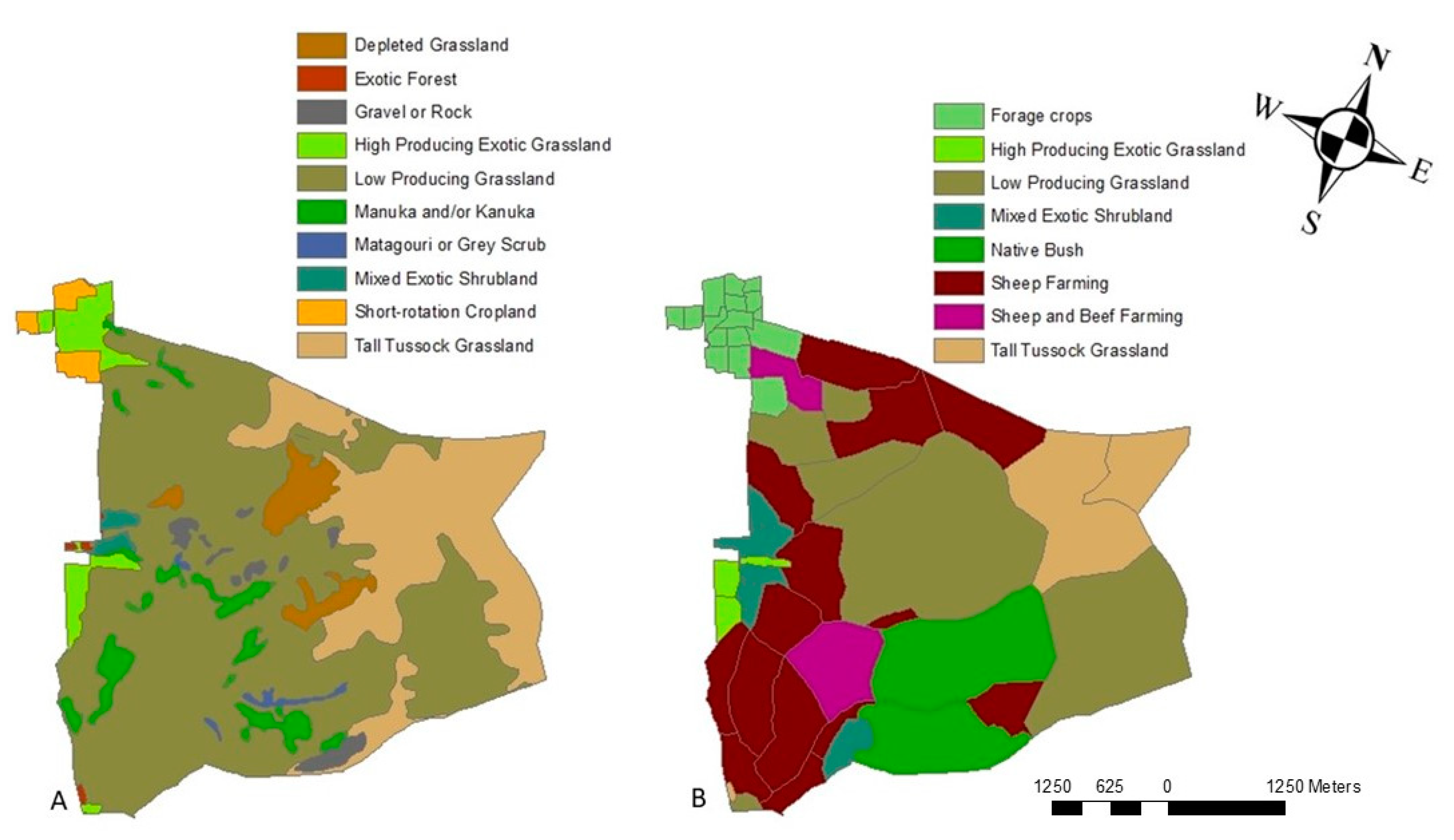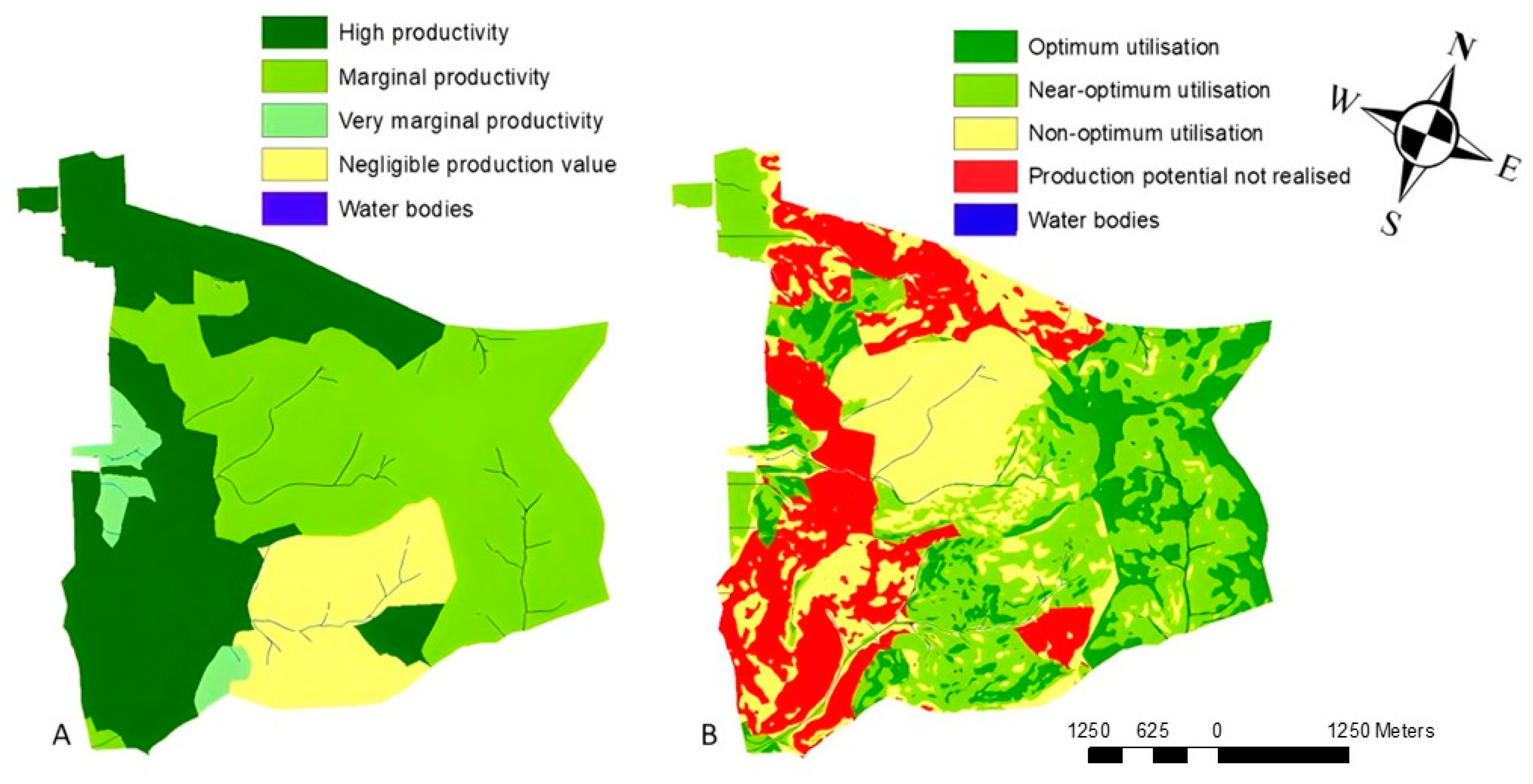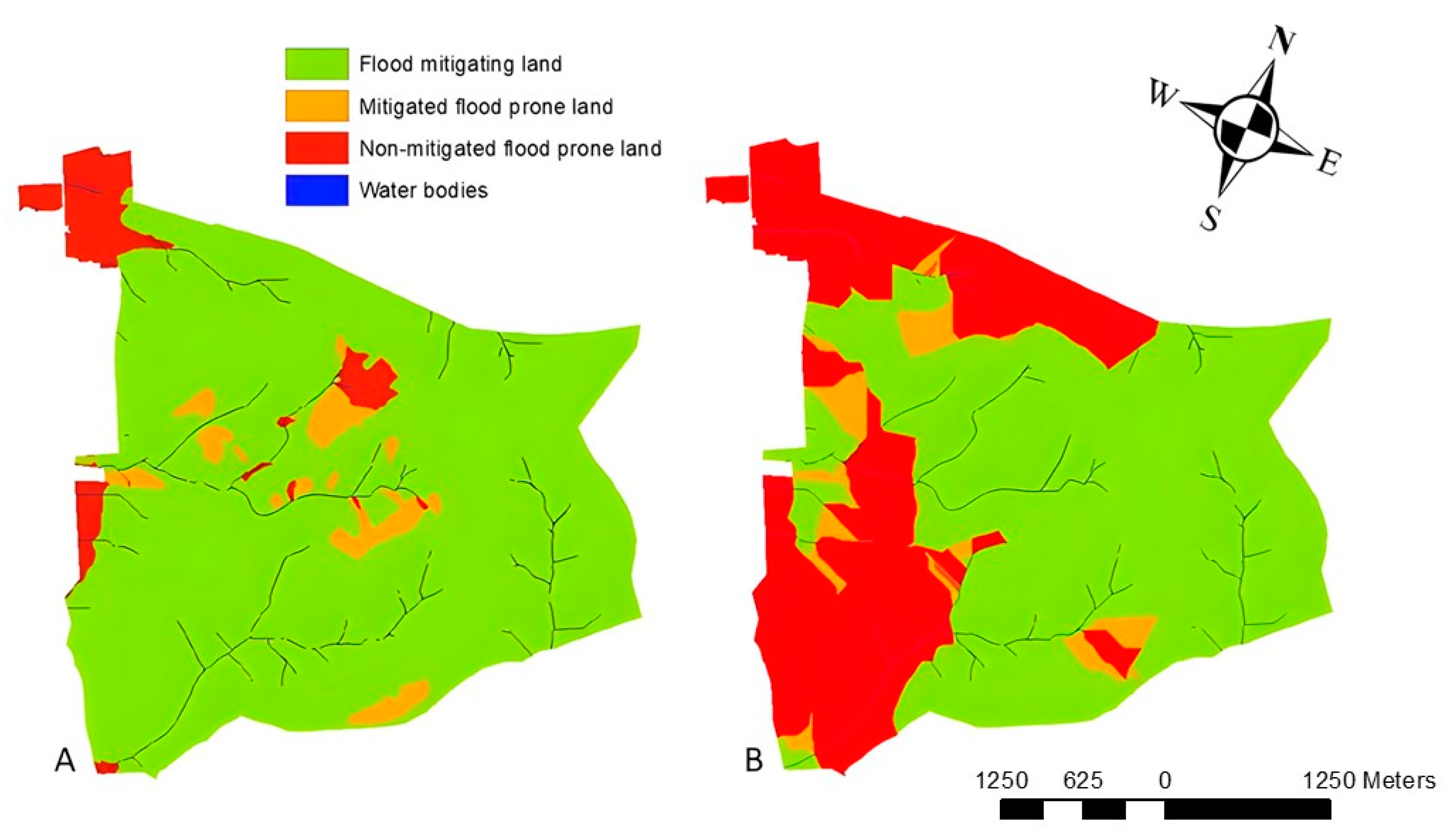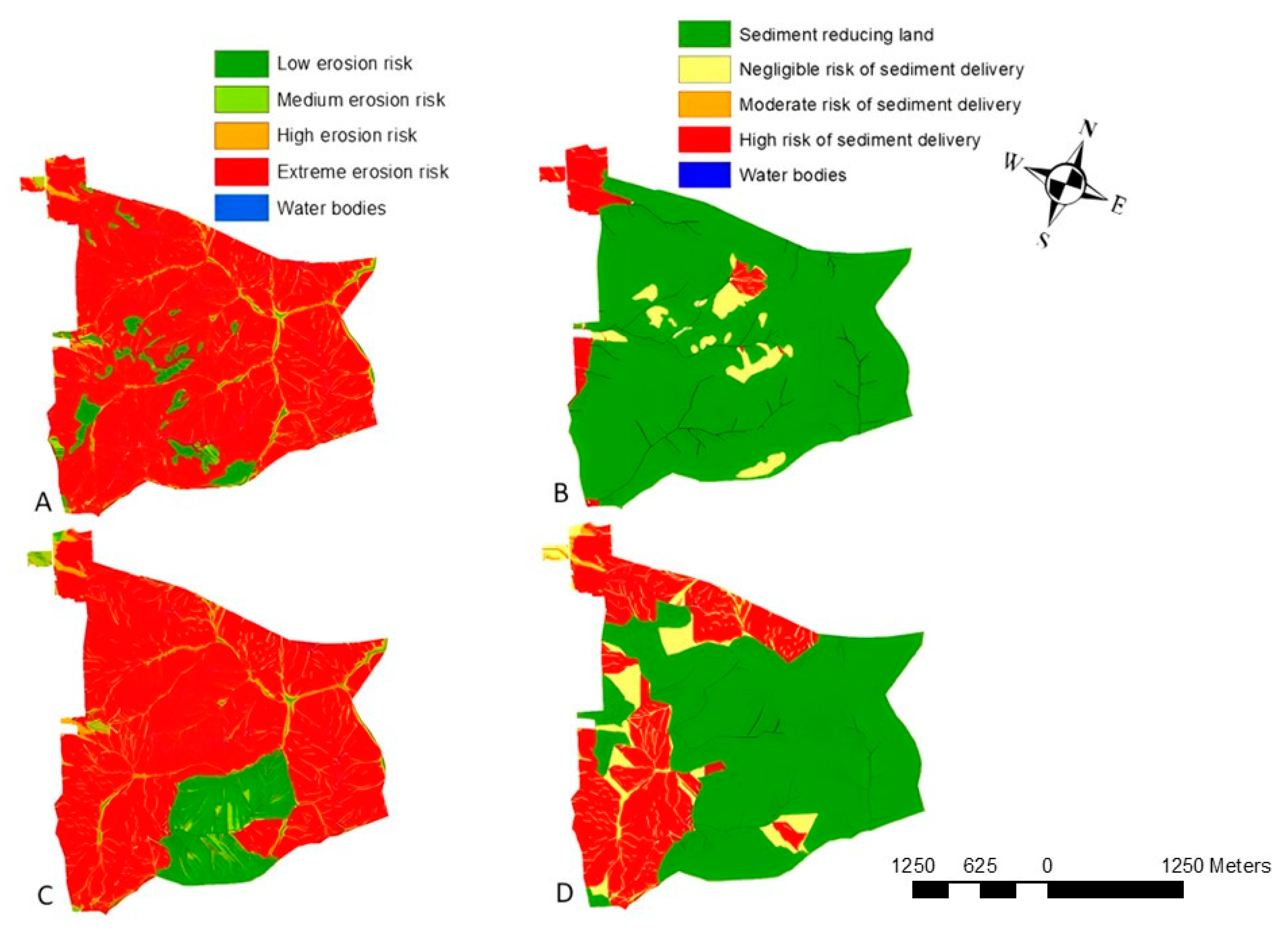A Geospatial Modelling Approach to Assess the Capability of High-Country Stations in Delivering Ecosystem Services
Abstract
:1. Introduction
Related Work
2. Materials and Methods
2.1. Case Study Application
2.2. LUCI Inputs
2.3. LUCI Ecosystem Services Tools and Sub-Models
2.3.1. Agricultural Productivity
2.3.2. Flood Mitigation
2.3.3. Carbon Sequestration
2.3.4. Erosion/Sediment Delivery
2.3.5. Nitrogen and Phosphorus Load
2.3.6. Trade-Off Tool
2.4. LUCI Outputs
3. Results
3.1. Agricultural Productivity
3.2. Flood Mitigation
3.3. Carbon Sequestration
3.4. Erosion/Sediment Delivery
3.5. Nitrogen and Phosphorus Load
3.6. Trade-Off Tool
4. Discussion
Limitations
5. Conclusions
Author Contributions
Funding
Data Availability Statement
Acknowledgments
Conflicts of Interest
References
- Sala, O.E.; Yahdjian, L.; Havstad, K.; Aguiar, M.R. Rangeland ecosystem services: Nature’s supply and humans’ demand. In Rangeland Systems; Briske, D.D., Ed.; Springer Nature: Cham, Switzerlan, 2017; pp. 467–489. [Google Scholar] [CrossRef] [Green Version]
- White, R.P.; Murray, S.; Rohweder, M.; Prince, S.D.; Thompson, K.M. Grassland Ecosystems; World Resources Institute: Washington, DC, USA, 2000. [Google Scholar]
- Zhao, Y.; Liu, Z.; Wu, J. Grassland ecosystem services: A systematic review of research advances and future directions. Landsc. Ecol. 2020, 35, 793–814. [Google Scholar] [CrossRef]
- Ramankutty, N.; Mehrabi, Z.; Waha, K.; Kremen, C.; Herrero, M.; Rieseberg, L.H. Trends in global agricultural land use: Implications for environmental health and food security. Annu. Rev. Plant. Biol. 2018, 69, 789–815. [Google Scholar] [CrossRef] [PubMed] [Green Version]
- Foley, J.A.; De Fries, R.; Asner, G.P.; Barford, C.; Bonan, G.; Carpenter, S.R.; Chapin, F.S.; Coe, M.T.; Daily, G.C.; Gibbs, H.K.; et al. Global consequences of land use. Science 2005, 309, 570–574. [Google Scholar] [CrossRef] [PubMed] [Green Version]
- Kanianska, R. Agriculture and its impact on land-use, environment, and ecosystem services. In Landscape Ecology—The Influences of Land Use and Anthropogenic Impacts of Landscape Creation; IntechOpen: London, UK, 2016; pp. 1–26. [Google Scholar]
- de Bello, F.; Lavorel, S.; Díaz, S.; Harrington, R.; Cornelissen, J.H.; Bardgett, R.D.; Berg, M.P.; Cipriotti, P.; Feld, C.K.; Hering, D.; et al. Towards an assessment of multiple ecosystem processes and services via functional traits. Biodivers. Conserv. 2010, 19, 2873–2893. [Google Scholar] [CrossRef]
- Power, A.G. Ecosystem services and agriculture: Tradeoffs and synergies. Phil. Trans. R. Soc. B 2010, 365, 2959–2971. [Google Scholar] [CrossRef]
- Duru, M.; Pontes, L.D.A.S.; Schellberg, J. Grassland Functional Diversity and Management for Enhancing Ecosystem Services and Reducing Environmental Impacts; Agroecosystem Diversity; Elsevier: Amsterdam, The Netherlands, 2019. [Google Scholar]
- Rowntree, J.E.; Stanley, P.L.; Maciel, I.C.F.; Thorbecke, M.; Rosenzweig, S.T.; Hancock, D.W.; Guzman, A.; Raven, M.R. Ecosystem Impacts and Productive Capacity of a Multi-Species Pastured Livestock System. Front. Sustain. Food Syst. 2020, 4, 544984. [Google Scholar] [CrossRef]
- Fathollahi, H.; Mousavi-Avval, S.H.; Akram, A.; Rafiee, S. Comparative energy, economic, and environmental analyses of forage production systems for dairy farming. J. Clean. Prod. 2018, 182, 852–862. [Google Scholar] [CrossRef]
- Rodríguez, J.P.; Beard, T.D., Jr.; Bennett, E.M.; Cumming, G.S.; Cork, S.J.; Agard, J.; Dobson, A.P.; Peterson, G.D. Trade-offs across space, time, and ecosystem services. Ecol. Soc. 2006, 11, 28. [Google Scholar] [CrossRef] [Green Version]
- Rallings, A.M.; Smukler, S.M.; Gergel, S.E.; Mullinix, K. Towards multifunctional land use in an agricultural landscape: A trade-off and synergy analysis in the Lower Fraser Valley, Canada. Landsc. Urban Plan. 2019, 184, 88–100. [Google Scholar] [CrossRef]
- McGranahan, D.A. Ecologies of scale: Multifunctionality connects conservation and agriculture across fields, farms, and landscapes. Land 2014, 3, 739–769. [Google Scholar] [CrossRef] [Green Version]
- Dominati, E.J.; Maseyk, F.J.; Mackay, A.D.; Rendel, J.M. Farming in a changing environment: Increasing biodiversity on farm for the supply of multiple ecosystem services. Sci. Total Environ. 2019, 662, 703–713. [Google Scholar] [CrossRef]
- Michalk, D.L.; Kemp, D.R.; Badgery, W.B.; Wu, J.; Zhang, Y.; Thomassin, P.J. Sustainability and future food security—A global perspective for livestock production. Land Degrad. Dev. 2019, 30, 561–573. [Google Scholar] [CrossRef]
- Schiere, J.B.; Gregorini, P. Complexity, Crash and Collapse of Chaos: Clues for Designing Sustainable Systems, with Focus on Grassland-Based Systems. Sustainability 2023, 15, 4356. [Google Scholar] [CrossRef]
- Pereira, F.C.; Smith, C.; Charters, S.M.; Gregorini, P. Creating a Design Framework to Diagnose and Enhance Grassland Health under Pastoral Livestock Production Systems. Animals 2022, 12, 3306. [Google Scholar] [CrossRef]
- Xue, R.; Yang, Q.; Miao, F.; Wang, X.; Shen, Y. Slope aspect influences plant biomass, soil properties and microbial composition in alpine meadow on the Qinghai-Tibetan plateau. J. Soil Sci. Plant Nutr. 2018, 18, 1–12. [Google Scholar] [CrossRef] [Green Version]
- Tran, D.X.; Pearson, D.; Palmer, A.; Gray, D.; Lowry, J.; Dominati, E.J. A comprehensive spatially-explicit analysis of agricultural landscape multifunctionality using a New Zealand hill country farm case study. Agric. Syst. 2022, 203, 103494. [Google Scholar] [CrossRef]
- Tran, D.X.; Pearson, D.; Palmer, A.; Lowry, J.; Gray, D.; Dominati, E.J. Quantifying spatial non-stationarity in the relationship between landscape structure and the provision of ecosystem services: An example in the New Zealand hill country. Sci. Total Environ. 2022, 808, 152126. [Google Scholar] [CrossRef]
- Sharps, K.; Masante, D.; Thomas, A.; Jackson, B.; Redhead, J.; May, L.; Prosser, H.; Cosby, B.; Emmett, B.; Jones, L. Comparing strengths and weaknesses of three ecosystem services modelling tools in a diverse UK river catchment. Sci. Total Environ. 2017, 584, 118–130. [Google Scholar] [CrossRef] [Green Version]
- Malinga, R.; Gordon, L.J.; Jewitt, G.; Lindborg, R. Mapping ecosystem services across scales and continents—A review. Ecosyst. Serv. 2015, 13, 57–63. [Google Scholar] [CrossRef]
- Owen-Smith, N. Credible models for herbivore-vegetation systems: Towards an ecology of equations. S. Afr. J. Sci. 2002, 98, 445–449. [Google Scholar]
- Land Utilisation & Capability Indicator. Available online: https://lucitools.org (accessed on 6 May 2023).
- Nature Braid. Available online: https://naturebraid.org/ (accessed on 6 May 2023).
- Jackson, B.; Pagella, T.; Sinclair, F.; Orellana, B.; Henshaw, A.; Reynolds, B.; Mcintyre, N.; Wheater, H.; Eycott, A. Polyscape: A GIS mapping framework providing efficient and spatially explicit landscape-scale valuation of multiple ecosystem services. Landsc. Urban Plan. 2013, 112, 74–88. [Google Scholar] [CrossRef]
- Trodahl, M.; Burkitt, L.; Bretherton, M.; Deslippe, J.; Jackson, B.; Metherell, A. Developing N & P Export Coefficients for Rural Landscape Modelling in LUCI. In Science and Policy: Nutrient Management Challenges for the Next Generation; Occasional Report No. 30; Currie, L.D., Hedley, M.J., Eds.; Fertilizer and Lime Research Centre, Massey University: Palmerston North, New Zealand, 2017; Available online: http://flrc.massey.ac.nz/publications.html (accessed on 15 September 2022).
- Duncan, R.; Lucas, D.; Palmer, C. Mt Grand Station: Baseline Survey for Vegetation and Soils 1997; Department of Plant Sciences, Lincoln University: Lincoln, New Zealand, 1997. [Google Scholar]
- Chapman, D.F.; Macfarlane, M.J. Pasture growth limitations in hill country and choice of species. NZGA Res. Pract. Ser. 1985, 3, 25–29. [Google Scholar] [CrossRef]
- Smith, C.; Jayathunga, S.; Gregorini, P.; Pereira, F.C.; McWilliam, W. Using Soil Sustainability and Resilience Concepts to Support Future Land Management Practice: A Case Study of Mt Grand Station, Hāwea, New Zealand. Sustainability 2022, 14, 1808. [Google Scholar] [CrossRef]
- Morris, S.T.; Kenyon, P.R. Intensive sheep and beef production from pasture—A New Zealand perspective of concerns, opportunities and challenges. Meat Sci. 2014, 98, 330–335. [Google Scholar] [CrossRef] [PubMed]
- Wang, Y.; Dai, E. Spatial-temporal changes in ecosystem services and the trade-off relationship in mountain regions: A case study of Hengduan Mountain region in Southwest China. J. Clean. Prod. 2020, 264, 121573. [Google Scholar] [CrossRef]
- Mason, N.W.; Palmer, D.J.; Vetrova, V.; Brabyn, L.; Paul, T.; Willemse, P.; Peltzer, D.A. Accentuating the positive while eliminating the negative of alien tree invasions: A multiple ecosystem services approach to prioritising control efforts. Biol. Invasions 2017, 19, 1181–1195. [Google Scholar] [CrossRef]
- de Groot, R.; Hein, L. Concept and valuation of landscape functions at di_erent scales. In Multifunctional Land Use; Springer: Berlin/Heidelberg, Germany, 2007; pp. 15–36. [Google Scholar]
- Maxwell, T.M.; Moir, J.L.; Edwards, G.R. Grazing and soil fertility effect on naturalized annual clover species in New Zealand high country. Rangel. Ecol. Manag. 2016, 69, 444–448. [Google Scholar] [CrossRef]
- Land Information New Zealand Data. Available online: https://data.linz.govt.nz/ (accessed on 5 June 2022).
- New Zealand Land Cover Database. Available online: https://lris.scinfo.org.nz/layer/104400-lcdb-v50-land-cover-database-version-50-mainland-new-zealand/ (accessed on 5 June 2022).
- National Soil Database. Available online: https://soils.landcareresearch.co.nz/ (accessed on 5 June 2022).
- Jackson, B.M.; Metherell, A.K.; Roberts, A.H.C.; Trodahl, M.I.; White, M. Adaption of the LUCI Framework to Account for Detailed Farm Management: A Case Study Exploring Potential for Nutrient Mitigation Using Data from the Southland Demonstration Farm. In Integrated Nutrient and Water Management for Sustainable Farming; Occasional Report No. 29; Currie, L.D., Singh, R., Eds.; Fertilizer and Lime Research Centre, Massey University: Palmerston North, New Zealand, 2016; Available online: http://flrc.massey.ac.nz/publication.html (accessed on 15 September 2022).
- Dang, N.A.; Benavidez, R.; Tomscha, S.A.; Nguyen, H.; Tran, D.D.; Nguyen, D.T.H.; Loc, H.H.; Jackson, B.M. Ecosystem Service Modelling to Support Nature-Based Flood Water Management in the Vietnamese Mekong River Delta. Sustainability 2021, 13, 13549. [Google Scholar] [CrossRef]
- Tomscha, S.A.; Bentley, S.; Platzer, E.; Jackson, B.; De Roiste, M.; Hartley, S.; Norton, K.; Deslippe, J.R. Multiple methods confirm wetland restoration improves ecosystem services. Ecosyst. People 2021, 17, 25–40. [Google Scholar] [CrossRef]
- Emmett, B.A.; Cooper, D.; Smart, S.; Jackson, B.; Thomas, A.; Cosby, B.; Evans, C.; Glanville, H.; McDonald, J.E.; Malham, S.K.; et al. Spatial patterns and environmental constraints on ecosystem services at a catchment scale. Sci. Total Environ. 2016, 572, 1586–1600. [Google Scholar] [CrossRef]
- Pereira, F.C.; Smith, C.M.; Maxwell, T.M.; Charters, S.M.; Logan, C.M.; Donovan, M.; Jayathunga, S.; Gregorini, P. Applying Spatial Analysis to Create Modern Rich Pictures for Grassland Health Analysis. Sustainability 2021, 13, 11535. [Google Scholar] [CrossRef]
- IPCC. Guidelines for National Greenhouse Gas Inventories. 2006. Available online: https://www.ipcc-nggip.iges.or.jp/public/2006gl/index.html (accessed on 2 September 2021).
- Wischmeier, W.H.; Smith, D.D. Predicting Rainfall Erosion Losses: A Guide to Conservation Planning (No. 537); Department of Agriculture, Science and Education Administration: Annapolis, MD, USA, 1978.
- Marshall, M.R.; Francis, O.J.; Frogbrook, Z.L.; Jackson, B.M.; McIntyre, N.; Reynolds, B.; Solloway, I.; Wheater, H.S.; Chell, J. The impact of upland land management on flooding: Results from an improved pasture hillslope. Hydrol. Process. 2009, 23, 464–475. [Google Scholar] [CrossRef]
- Bond, S.; Kirkby, M.J.; Johnston, J.; Crowle, A.; Holden, J. Seasonal vegetation and management influence overland flow velocity in upland grasslands-dataset. Hydrol. Process. 2020, 34, 3777–3791. [Google Scholar] [CrossRef]
- Monger, F.; Bond, S.; Spracklen, D.V.; Kirkby, M.J. Overland flow velocity and soil properties in established semi-natural woodland and wood pasture in an upland catchment. Hydrol. Process. 2022, 36, e14567. [Google Scholar] [CrossRef]
- Archer, N.A.L.; Bonell, M.; Coles, N.; MacDonald, A.M.; Auton, C.A.; Stevenson, R. Soil characteristics and landcover relationships on soil hydraulic conductivity at a hillslope scale: A view towards local flood management. J. Hydrol. 2013, 497, 208–222. [Google Scholar] [CrossRef] [Green Version]
- Greenwood, K.L.; McKenzie, B.M. Grazing effects on soil physical properties and the consequences for pastures: A review. Aust. J. Exp. Agric. 2001, 41, 1231–1250. [Google Scholar] [CrossRef]
- Donovan, M.; Monaghan, R. Impacts of grazing on ground cover, soil physical properties and soil loss via surface erosion: A novel geospatial modelling approach. J. Environ. Manag. 2021, 287, 112206. [Google Scholar] [CrossRef] [PubMed]
- Wagner, P.M.; Abagandura, G.O.; Mamo, M.; Weissling, T.; Wingeyer, A.; Bradshaw, J.D. Abundance and Diversity of Dung Beetles (Coleoptera: Scarabaeoidea) as Affected by Grazing Management in the Nebraska Sandhills Ecosystem. Environ. Entomol. 2021, 50, 222–231. [Google Scholar] [CrossRef]
- Gosnell, H.; Charnley, S.; Stanley, P. Climate change mitigation as a co-benefit of regenerative ranching: Insights from Australia and the United States: CC Mitigation and Regenerative Ranching. Interface Focus 2020, 10, 20200027. [Google Scholar] [CrossRef] [PubMed]
- Wei, Y.; Zhang, Y.; Wilson, G.W.; Guo, Y.; Bi, Y.; Xiong, X.; Liu, N. Transformation of litter carbon to stable soil organic matter is facilitated by ungulate trampling. Geoderma 2021, 385, 114828. [Google Scholar] [CrossRef]
- Pereira, F.C.; Donovan, M.; Smith, C.M.; Charters, S.; Maxwell, T.M.; Gregorini, P. A Geospatial Modelling Approach to Understand the Spatio-Temporal Impacts of Grazing on Soil Susceptibility to Erosion. Soil Syst. 2023, 7, 30. [Google Scholar] [CrossRef]
- Mackay, A.D.; Wedderburn, M.E.; Lambert, M.G. Sustainable management of hill land. In Proceedings of the New Zealand Grassland Association; New Zealand Grassland Association: Dunedin, New Zealand, 1993; pp. 171–176. [Google Scholar]
- McDowell, R.; Wilcock, R. Water Quality and the Effects of Different Pastoral Animals. N. Z. Vet. J. 2008, 56, 289–296. [Google Scholar] [CrossRef] [PubMed]
- Voisin, A. Produtividade do Pasto; Mestre Jou: São Paulo, Brazil, 1974. [Google Scholar]
- Teague, R.; Provenza, F.; Kreuter, U.; Steffens, T.; Barnes, M. Multi-paddock grazing on rangelands: Why the perceptual dichotomy between research results and rancher experience? J. Environ. Manag. 2013, 128, 699–717. [Google Scholar] [CrossRef] [PubMed]
- Woznicki, S.A.; Cada, P.; Wickham, J.; Schmidt, M.; Baynes, J.; Mehaffey, M.; Neale, A. Sediment retention by natural landscapes in the conterminous United States. Sci. Total Environ. 2020, 745, 140972. [Google Scholar] [CrossRef]
- Basher, L.; Moores, J.; McLean, G. Scientific Basis for Erosion and Sediment Control Practices in New Zealand; Landcare Research: Nelson, New Zealand, 2016; pp. 1–121. [Google Scholar]
- McDonald, S.E.; Reid, N.; Waters, C.M.; Smith, R.; Hunter, J. Improving ground cover and landscape function in a semi-arid rangeland through alternative grazing management. Agric. Ecosyst. Environ. 2018, 268, 8–14. [Google Scholar] [CrossRef]
- Badgery, W.B.; Millar, G.D.; Broadfoot, K.; Michalk, D.L.; Cranney, P.; Mitchell, D.; Van De Ven, R. Increased production and cover in a variable native pasture following intensive grazing management. Anim. Prod. Sci. 2017, 57, 1812–1823. [Google Scholar] [CrossRef] [Green Version]
- McDowell, R.W.; Nash, D. A review of the cost-effectiveness and suitability of mitigation strategies to prevent phosphorus loss from dairy farms in New Zealand and Australia. J. Environ. Qual. 2012, 41, 680–693. [Google Scholar] [CrossRef]
- Nguyen, M.L.; Sheath, G.W.; Smith, C.M.; Cooper, A.B. Impact of cattle treading on hill land: 2. Soil physical properties and contaminant runoff. N. Z. J. Agric. Res. 1998, 41, 279–290. [Google Scholar] [CrossRef] [Green Version]
- Gerber, P.J.; Steinfeld, H.; Henderson, B.; Mottet, A.; Opio, C.; Dijkman, J.; Falcucci, A.; Tempio, G. Tackling Climate Change through Livestock—A Global Assessment of Emissions and Mitigation Opportunities; Food and Agriculture Organization of the United Nations (FAO): Rome, Italy, 2013; ISBN 9789251079201.
- Stanley, P.L.; Rowntree, J.E.; Beede, D.K.; DeLonge, M.S.; Hamm, M.W. Impacts of soil carbon sequestration on life cycle greenhouse gas emissions in Midwestern USA beef finishing systems. Agric. Syst. 2018, 162, 249–258. [Google Scholar] [CrossRef]
- Machado Filho, L.C.P.; Seó, H.L.; Daros, R.R.; Enriquez-Hidalgo, D.; Wendling, A.V.; Pinheiro Machado, L.C. Voisin rational grazing as a sustainable alternative for livestock production. Animals 2021, 11, 3494. [Google Scholar] [CrossRef]
- Pereira, F.C.; Machado Filho, L.C.P.; Kazama, D.C.S.; Júnior, R.G.; Pereira, L.G.R.; Enríquez-Hidalgo, D. Effect of recovery period of mixture pasture on cattle behaviour, pasture biomass production and pasture nutritional value. Animal 2020, 14, 1961–1968. [Google Scholar] [CrossRef] [PubMed]
- Lorenz, K.; Lal, R. Soil organic carbon sequestration in agroforestry systems. A Review. Agron. Sustain. Dev. 2014, 34, 443–454. [Google Scholar] [CrossRef] [Green Version]
- Wyatt, R.M.; Hodges, L.D.; Kalafatis, N.; Wright, P.F.; Wynne, P.M.; Macrides, T.A. Phytochemical analysis and biological screening of leaf and twig extracts from Kunzea ericoides. Phytother. Res. 2005, 19, 963–970. [Google Scholar] [CrossRef] [PubMed]
- Villalba, J.J.; Beauchemin, K.A.; Gregorini, P.; MacAdam, J.W. Pasture chemoscapes and their ecological services. Transl. Anim. Sci. 2019, 3, 829–841. [Google Scholar] [CrossRef] [PubMed] [Green Version]
- Pereira, F.C.; Gregorini, P. Applying spatio-chemical analysis to grassland ecosystems for the illustration of chemoscapes and creation of healthscapes. Front. Sustain. Food Syst. 2022, 6, 927568. [Google Scholar] [CrossRef]
- Ausseil, A.E.; Dymond, J.R.; Newstrom, L. Mapping floral resources for honey bees in New Zealand at the catchment scale. Ecol. Appl. 2018, 28, 1182–1196. [Google Scholar] [CrossRef]
- Dominati, E.J.; Mackay, A.; Lynch, B.; Heath, N.; Millner, I. An ecosystem services approach to the quantification of shallow mass movement erosion and the value of soil conservation practices. Ecosyst. Serv. 2014, 9, 204–215. [Google Scholar] [CrossRef]
- Powers, B.F.; Ausseil, A.-G.; Perry, G.L.W. Ecosystem service management and spatial prioritisation in a multifunctional landscape in the Bay of Plenty, New Zealand. Australas. J. Environ. Manag. 2020, 27, 275–293. [Google Scholar] [CrossRef]
- Wilson, C.H.; Strickland, M.S.; Hutchings, J.A.; Bianchi, T.S.; Flory, S.L. Grazing enhances belowground carbon allocation, microbial biomass, and soil carbon in a subtropical grassland. Glob. Change Biol. 2018, 24, 2997–3009. [Google Scholar] [CrossRef]
- Kristensen, J.A.; Svenning, J.C.; Georgiou, K.; Malhi, Y. Can large herbivores enhance ecosystem carbon persistence? Trends Ecol. Evol. 2021, 37, 117–128. [Google Scholar] [CrossRef]









Disclaimer/Publisher’s Note: The statements, opinions and data contained in all publications are solely those of the individual author(s) and contributor(s) and not of MDPI and/or the editor(s). MDPI and/or the editor(s) disclaim responsibility for any injury to people or property resulting from any ideas, methods, instructions or products referred to in the content. |
© 2023 by the authors. Licensee MDPI, Basel, Switzerland. This article is an open access article distributed under the terms and conditions of the Creative Commons Attribution (CC BY) license (https://creativecommons.org/licenses/by/4.0/).
Share and Cite
Pereira, F.C.; Charters, S.; Smith, C.M.S.; Maxwell, T.M.R.; Gregorini, P. A Geospatial Modelling Approach to Assess the Capability of High-Country Stations in Delivering Ecosystem Services. Land 2023, 12, 1243. https://doi.org/10.3390/land12061243
Pereira FC, Charters S, Smith CMS, Maxwell TMR, Gregorini P. A Geospatial Modelling Approach to Assess the Capability of High-Country Stations in Delivering Ecosystem Services. Land. 2023; 12(6):1243. https://doi.org/10.3390/land12061243
Chicago/Turabian StylePereira, Fabiellen C., Stuart Charters, Carol M. S. Smith, Thomas M. R. Maxwell, and Pablo Gregorini. 2023. "A Geospatial Modelling Approach to Assess the Capability of High-Country Stations in Delivering Ecosystem Services" Land 12, no. 6: 1243. https://doi.org/10.3390/land12061243
APA StylePereira, F. C., Charters, S., Smith, C. M. S., Maxwell, T. M. R., & Gregorini, P. (2023). A Geospatial Modelling Approach to Assess the Capability of High-Country Stations in Delivering Ecosystem Services. Land, 12(6), 1243. https://doi.org/10.3390/land12061243




